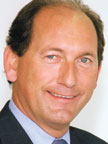
With 1.2 billion people buying Nestlé products every day, chances are you’ve got a few in your cupboard.
Ranging from baby cereal to Baby Ruth, products not only touch a number of categories but — within each segment — a range of price points. Poland Springs is a Nestlé brand and so is S.Pellegrino.
“We have a broad portfolio and that is intentionally so, because we want to be a meaningful part of people’s lives, on a nutritional basis, throughout their whole life, every moment of their life,” said Paul Bulcke, chief executive officer of Nestlé S.A., Vevey, Switzerland.
A diverse lineup helped Nestlé achieve $10.4 billion in U.S. sales last year, and a total of $99 billion globally. With 1.4% organic growth, it outperformed its competitors.
“Nestlé fared better than most, growing both top line and bottom line,” noted Neil Stern, senior partner at McMillan Doolittle, Chicago. “Paul has provided very stable and balanced leadership during this time.”
Bulcke’s focus on innovation has given Nestlé products relevancy even during the recession. The company’s 28 R&D centers are designed for continuous innovation as it relates to nutrition, but especially taste.
“Our R&D is really set up to look for enjoyable food,” said Bulcke.
Hitting the mark last year were Skinny Cow low-calorie ice cream sandwiches, cones and bars with growth of more than 25%. Nescafé, a 70-plus-year-old brand, grew 7% thanks to flavor- and aroma-capturing innovations.
Nestlé also adds to its portfolio through acquisition. Strengthening its frozen food lineup is the successful frozen pizza business it acquired from Kraft in January for $3.7 billion. It includes brands like DiGiorno, Tombstone, California Pizza Kitchen, Jack’s and Dellisios.
“It really solidifies [Nestlé’s] presence in the frozen category,” observed Stern. “They appear to be in very good shape to emerge from this recession even stronger than they came in.”
Under Bulcke’s watch, Nestlé is also putting inventive merchandising strategies in place in emerging markets.
The company launched a 90-foot barge on an 18-day trip up the Amazon River in Brazil, according to a Fortune magazine report.
Stocked with more than 300 brands like Leche Ideal enhanced powdered milk, Maggi soups and Nescafé instant coffee, it docked at river ports to hawk small, low-priced items to Brazilians.
Nestlé is also meeting the individualized health needs of regions across the globe. Addressing iron, iodine, zinc and vitamin A deficiencies is Nestlé’s fortified milk sold at affordable prices. It became available in 60 countries in 2009, up from 40 countries the previous year, and is projected to hit 70 by the end of 2010.
“We are totally convinced that our company can only be successful as a company — and that is creating shareholder value successfully over time — when we also connect very meaningfully and positively with society at large,” Bulcke said.
In that vein, he’s committed to the Nestlé Healthy Kids Global Programme with the goal of improving school age children’s knowledge of healthy lifestyles in partnership with governments, NGOs and academia. Bulcke hopes to implement it in all of the countries where it operates by 2011.


